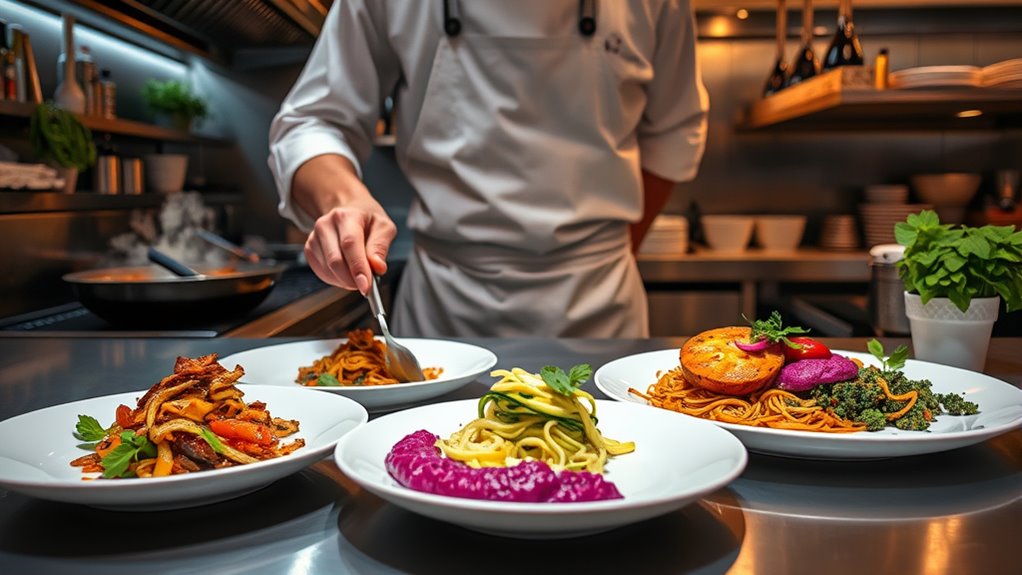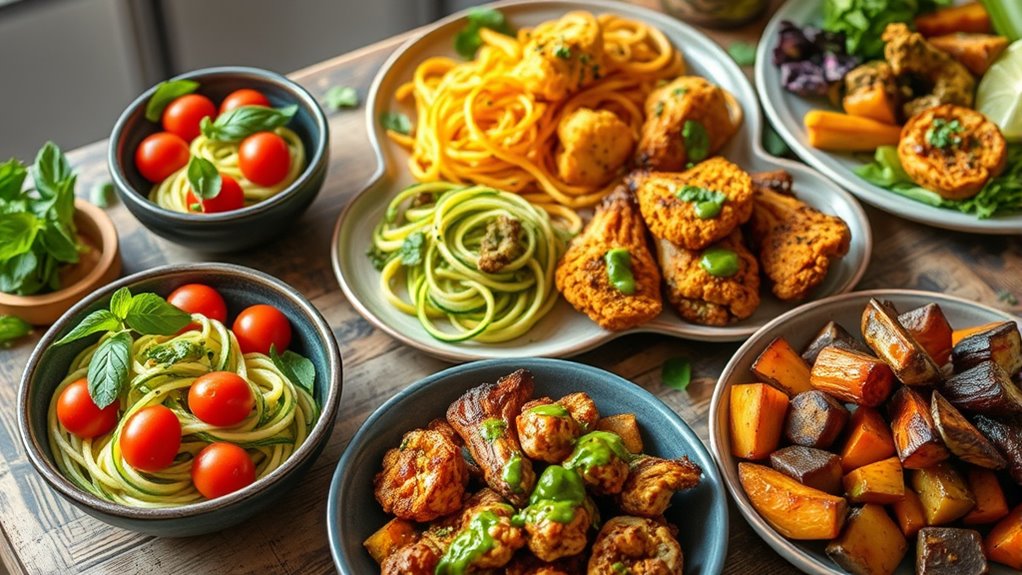Veganism is transforming world cuisine by inspiring chefs to rethink traditional dishes using innovative plant-based techniques, flavors, and presentations that appeal to both vegans and omnivores. They are going beyond simple replacements, creating complex textures, and showcasing the versatility of ingredients like legumes, grains, and fungi. This movement encourages more sustainable practices and pushes culinary boundaries. If you want to discover how these chefs are redefining dishes globally, there’s plenty more to explore.
Key Takeaways
- Chefs are reimagining traditional dishes with plant-based ingredients, emphasizing creativity, textures, and flavors beyond simple replacements.
- The focus on sustainability drives innovation in sourcing local, seasonal produce and reducing waste in culinary practices.
- Advanced techniques like fermentation and extrusion enable chefs to replicate meat textures and enhance visual appeal of vegan dishes.
- Mainstreaming vegan options with clear labeling and complex flavors attracts diverse diners, broadening vegan cuisine’s cultural impact.
- Veganism is challenging culinary boundaries, fostering diverse, inventive, and sustainable world cuisines that appeal globally.

Veganism is transforming the way we approach and experience food, pushing chefs and restaurants to innovate beyond traditional ingredients. This shift isn’t just about replacing meat with vegetables; it’s about reimagining entire dishes and culinary concepts through plant-based innovations. Chefs worldwide are exploring new techniques, flavors, and textures that highlight the versatility of plant ingredients, creating exciting dishes that appeal to both vegans and omnivores alike. These innovations challenge the conventional boundaries of cuisine, encouraging chefs to think creatively about how to deliver satisfying, flavorful experiences without animal products.
One of the key drivers of this evolution is the focus on culinary sustainability. As concerns about environmental impact grow, chefs are adopting more sustainable practices that minimize waste and reduce carbon footprints. They’re sourcing local, seasonal produce, experimenting with plant-based proteins like legumes, grains, and innovative meat substitutes, and designing menus that prioritize eco-friendly ingredients. This approach not only reduces the environmental costs associated with traditional animal agriculture but also encourages consumers to consider the broader implications of their food choices. By integrating sustainability into their culinary philosophy, chefs are making a statement that delicious, eco-conscious food can be accessible and appealing.
Plant-based innovations are at the heart of this transformation. From jackfruit pulled “pork” to mushroom-based “meat,” these ingredients allow chefs to replicate textures and flavors traditionally associated with meat, opening up new possibilities for dishes that are both satisfying and ethical. Advanced techniques like fermentation, extrusion, and precision cooking help create plant-based products that mimic the taste and mouthfeel of animal-derived ingredients, making the transition to vegan dining seamless for many. These innovations also push the boundaries of culinary creativity, inspiring chefs to develop new recipes and presentation styles that captivate diners and challenge preconceptions about what vegan food can be. Furthermore, the use of color accuracy in food presentation, such as plating and lighting, enhances the visual appeal of plant-based dishes, making them even more enticing.
Furthermore, as veganism becomes more mainstream, restaurants are recognizing the importance of inclusivity. Menus now often feature clearly marked vegan options, and chefs are designing dishes that go beyond simple salads or tofu stir-fries. They’re crafting complex, multi-layered flavors that showcase the potential of plant-based ingredients to stand on their own. This cultural shift not only broadens the appeal of vegan cuisine but also fosters a deeper appreciation for food as a tool for positive change. Ultimately, the movement towards plant-based innovations and culinary sustainability is reshaping world cuisine, making it more diverse, environmentally responsible, and deliciously inventive—something you’ll notice the next time you dine out or cook at home.
Frequently Asked Questions
How Is Veganism Influencing Traditional Cooking Techniques Globally?
You’re seeing how veganism influences traditional cooking techniques through plant-based fusion and culinary adaptation. Chefs worldwide are reimagining classic dishes by replacing animal products with plant ingredients, creating innovative flavors. This shift encourages you to experiment with new textures and methods, blending cultural techniques with plant-based options. As a result, traditional cuisines evolve, making them more inclusive and sustainable, while inspiring you to explore diverse, eco-friendly culinary innovations.
Are There Specific Ingredients Becoming More Popular Due to Vegan Trends?
You’ll notice that plant-based proteins like jackfruit, tempeh, and tofu are gaining popularity, replacing traditional meats. Dairy alternatives such as almond milk, coconut yogurt, and cashew cheese are also soaring in use. These ingredients are becoming staples in many dishes, allowing you to enjoy familiar flavors while embracing vegan trends. As a result, your cooking options expand, making it easier to create delicious, ethical, and sustainable meals.
How Do Vegan Dishes Maintain Cultural Authenticity?
You can maintain culinary authenticity in vegan dishes by embracing plant-based fusion techniques that respect traditional flavors while innovating with new ingredients. Chefs often adapt classic recipes using local, plant-based ingredients, ensuring the essence of the cuisine remains intact. This approach preserves cultural authenticity, allowing dishes to stay true to their roots while highlighting the versatility and richness of plant-based cuisine in a global context.
What Challenges Do Chefs Face When Creating Vegan Versions of Classic Recipes?
When creating vegan versions of classic recipes, you face challenges like ingredient substitution, which requires finding replacements that mimic traditional flavors and textures. You also need to focus on flavor balancing, ensuring the dish remains authentic and satisfying. These tasks demand creativity and skill, as you must adapt recipes without compromising their cultural essence. Overcoming these challenges allows you to craft vegan dishes that respect tradition while appealing to modern tastes.
Is Vegan Cuisine Becoming More Accessible in Rural or Less Developed Areas?
You might think vegan cuisine is mainly for cities, but rural adoption is growing as local adaptation improves access to plant-based ingredients. Farmers and communities now embrace vegan options, making it easier for everyone to try new dishes. While challenges remain, increased awareness and supply chain changes are helping vegan food become more available in less developed areas, creating a more inclusive culinary landscape for all.
Conclusion
As you explore this culinary revolution, you’ll see veganism is like a fresh breeze sweeping through world cuisine, opening doors to new flavors and ideas. Chefs are embracing plant-based creativity, transforming dishes into vibrant, compassionate works of art. So, keep an open mind and savor the journey—this movement isn’t just changing menus, it’s reshaping the way you experience food. Embrace the change, and let your palate be your guide in this exciting, flavorful evolution.










